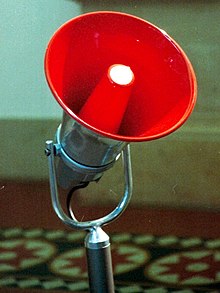Mouthpiece

A speaking tube (formerly also known as speaking tube or speaking tube ) is a device that directs the propagation of sound and thus improves the intelligibility, especially of spoken language, even at a greater distance between the listener and the speaker.
There are basically two types of construction: the open and the closed mouthpiece.
Open mouthpiece (megaphone)
The open mouthpiece, nowadays mostly referred to as a megaphone or megaphone and also colloquially casually as a whisper bag , is a funnel-shaped cover that is often made of sheet metal . The speaker takes the smaller of the two openings in front of his mouth while turning the larger one towards the listener.
The open mouthpiece was invented as a "speaking trumpet" in 1670 by the Englishman Samuel Morland , who made the first out of glass , iron or copper and used a conical funnel. Morland obviously knew that the shape he had chosen would not yet guide the sound propagation optimally. Therefore, he asked other scientists to develop better forms. Laurent Cassegrain succeeded in doing this by chance in 1672, who gave the funnel a hyperbolic shape (initially for aesthetic reasons) and discovered that this significantly improved its effectiveness.
Johann Heinrich Lambert first proposed a theory of the mouthpiece in the 18th century . This has proven that the hyperbolic shape is optimal, which is why modern megaphones almost exclusively use this.
Electric megaphone
Modern megaphones usually have an electrical voice amplifier consisting of a microphone , an amplifier and a loudspeaker , behind which the actual speaking tube is placed. The efficiency is 10% higher than with conventional loudspeakers, but with a much higher distortion factor . In mobile, mostly battery-operated versions, they are used like their purely acoustic predecessors. In Germany, the output power of mobile megaphones is limited to 120 dB in order to avoid hearing damage to bystanders. In the much more common stationary version, e.g. B. on platforms, megaphones represent directional speakers whose frequency characteristics in contrast to z. B. Concert music boxes is optimized for speech. Modern handheld megaphones also often offer completely new possibilities, for example they have integrated siren signal generators or are able to generate melodies. In this way, attention can be obtained quickly and comfortably for those present without having to rely directly on the human voice.
Closed mouthpiece
With a closed speaking tube (also known as communication tube ), the tube is not funnel-shaped, but has the same width over the entire length. In contrast to the open mouthpiece, the mouthpiece must reach just before the listener's hearing, which is why closed mouthpieces are usually much longer. Most of the time, they are used to connect two distant rooms directly with each other and thus enable spoken words to be transmitted. Soft noises can still be heard through a 950 m long pipe . These speaking tubes are used on ships to ensure technically simple and safe speech connections between the most important points (e.g. bridge and engine room) even in an emergency. For this purpose, however, there are now telephones that work without an external power supply. Another application was for a voice connection between the cab and the previously used for crew transport structure when using trucks z. B. as a team vehicle for disaster control organizations such as the THW .
Metaphorical meaning
In a figurative sense, a mouthpiece is an organ such as B. a newspaper that expresses the opinions and wishes of a person or group to the outside world. The term is sometimes also used critically for people who express the opinion of another in an uncritical and unreflective manner ("to be someone's mouthpiece").
See also
Individual evidence
- ↑ Jean Henri Hassenfratz : Comments on the true cause of the amplification of sound by the speech tube . In: Annalen der Physik , Vol. 19 (1805), 2nd piece, pp. 145–154, ISSN 0003-3804 .


